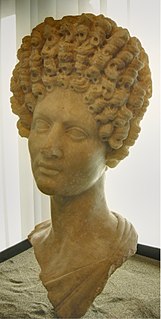
The sac spiders of the family Clubionidae have a very confusing taxonomic history. Once, this family was a large catch-all taxon for a disparate collection of spiders, similar only in that they had eight eyes arranged in two rows and conical anterior spinnerets that touched, and were wandering predators that built silken retreats, or sacs, usually on plant terminals, between leaves, under bark, or under rocks. These are now recognized to include several families, some of which are more closely related to the three-clawed spiders, like lynx and wolf spiders, than to Clubionidae and related families.

Vibia Sabina (83–136/137) was a Roman Empress, wife and second cousin once removed to Roman Emperor Hadrian. She was the daughter of Matidia and suffect consul Lucius Vibius Sabinus.

Salonia Matidia was the daughter and only child of Ulpia Marciana and wealthy praetor Gaius Salonius Matidius Patruinus. Her maternal uncle was the Roman emperor Trajan. Trajan had no children and treated her like his daughter. Her father died in 78 CE and Matidia went with her mother to live with Trajan and his wife, Pompeia Plotina.

Ulpia Marciana was the beloved elder sister of Roman Emperor Trajan. She was the eldest child born to Roman woman Marcia and the Roman senator Marcus Ulpius Traianus. Her second name Marciana she inherited from her mother’s paternal ancestors. Her birthplace is unknown.

Mindia Matidia or Vibia Matidia or Matidia Minor was related to several important ancient Roman Emperors. The modern village of Matigge Italy, is named after her.

Hersilia, also known as long-spinnered bark spiders and two-tailed spiders, is a genus of tree trunk spiders that was first described by Jean Victoire Audouin in 1826. Their nicknames are a reference to their greatly enlarged spinnerets.
Rupilia Faustina was an influential Roman noblewoman. She was the daughter of Salonina Matidia and suffect consul Lucius Scribonius Libo Rupilius Frugi Bonus. She possibly had another sister called Rupilia Annia.
Quercus flagellifera is a species of oak tree in the family Fagaceae.
Gaius Saloninus Matidius Patruinus was a Roman Senator who lived in the Roman Empire during the 1st century during the reign of Vespasian.
Libo Rupilius Frugi, whose full name was Lucius Scribonius Libo Rupilius Frugi Bonus, was a Roman suffect consul and a possible ancestor of the emperor Marcus Aurelius.
Lucius Vibius Sabinus was a Roman Senator who lived in the 1st century. His daughter Vibia Sabina married the emperor Hadrian. Little is known about his family, but Sabinus came from a family of consular rank. He may have been related to Lucius Junius Quintus Vibius Crispus, three times consul, and his brother Quintus Vibius Secundus, consul in 86. Sabinus became the second husband of Trajan's niece Salonina Matidia; he and Matidia had a daughter, Vibia Sabina (83-136/137). Sabinus may have died soon after his daughter's birth, for in his funeral speech for Matidia, the emperor Hadrian alludes to her long widowhood. Vibia Sabina married her distant maternal cousin and Trajan's heir, the future emperor Hadrian sometime before the year 101.
Lucius Mindius is an unattested Roman Aristocrat who lived in the Roman Empire in the second half of the 1st century. Mindius was a Roman Senator of Consular rank. Little is known on his origins. In 84, Mindius married Salonina Matidia, the niece of future Roman Emperor Trajan, becoming her second husband. Matidia was previously widowed from her first marriage to suffect consul Lucius Vibius Sabinus, who left Matidia a daughter Vibia Sabina.
Dorstenia flagellifera is a plant species in the family Moraceae which is native to Haiti.

Spiders are air-breathing arthropods that have eight legs, chelicerae with fangs generally able to inject venom, and spinnerets that extrude silk. They are the largest order of arachnids and rank seventh in total species diversity among all orders of organisms. Spiders are found worldwide on every continent except for Antarctica, and have become established in nearly every habitat with the exceptions of air and sea colonization. As of July 2019, at least 48,200 spider species, and 120 families have been recorded by taxonomists. However, there has been dissension within the scientific community as to how all these families should be classified, as evidenced by the over 20 different classifications that have been proposed since 1900.

Pseudactinia is a genus of sea anemones in the family Actiniidae.
Matidia is a genus of southeast Asian sac spiders first described by Tamerlan Thorell in 1878.
Matidia simplex, is a species of spider of the genus Matidia. It is endemic to Sri Lanka.

Cardamine flagellifera, commonly known as Blue Ridge bittercress, is a species of herbaceous plant in the mustard family. It is native to eastern North America, where it is found primarily in the southern Blue Ridge. It is a perennial that produces white flowers in the spring.








